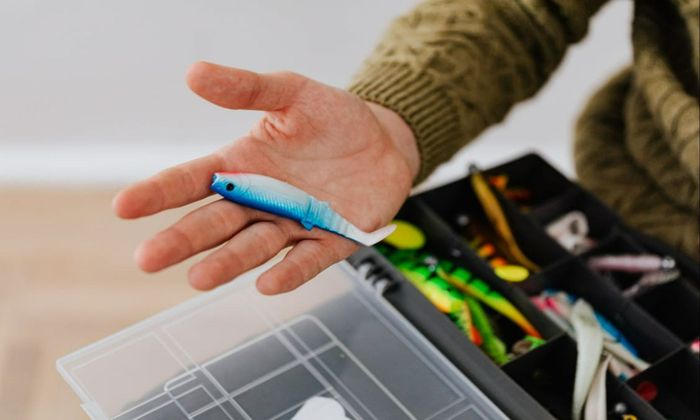Soft Bait Versus Hard Bait for Bass
Experienced anglers know there's more to fishing than Bass. See this guide to Soft versus Hard Bait for Bass.

Many anglers often use electronic equipment such as depth finders to determine where fish are underneath the surface. This helps them choose the appropriate bait or lure for their target species.
Bass are unique because they dwell at varying depths and are dependent on external factors. So determining where these fish are in the water column can be a daunting but rewarding task. However, once you find the bass, it will ultimately determine which lure you will use, whether it's a soft bait or hard bait.
Let's look at the difference between the two types of bait.

The Difference Between Soft Baits and Hard Baits

1. Soft Baits
As the name implies, soft baits are bait made of any rigid material. Anglers who wish to go for a more natural-looking presentation or are used to live baits often choose soft baits because they have a familiar texture and color. These types of bait can easily take on odors as well.
Soft baits are easy to use, so don't be surprised if you're new to an area and the local tackle shop suggests it. These baits are affordable and are easier to handle and maneuver since they can twist, bend, and are less likely to snag. They are even hardy enough to take on the current of a river.
Live bait is also categorized as a form of soft bait, which includes all your bugs, bees, fish eggs, crayfish, baitfish, grubs, and last but not least, worms. These soft baits typically work best in calm freshwater but may not be your lure of choice in muddy or turbid conditions.
While soft baits have been the bait of choice for years, plastic versions were developed only in the mid to late 20th century. Although initially not realistic enough for fish to take enough interest in, soft baits eventually evolved to look more natural to give it a familiar look that you know today, such as frogs, shads, and crabs.
Soft plastics are best used in various creative rigs, which have proven to be essential to any bass angler. So whether you need a bobber or a weighted jighead, creating a custom makeshift rig will increase the efficiency of a soft bait which makes them highly versatile since they can be fished at almost any depth. With that said, a Texas Rig is best for weeded areas; a Carolina rig can cover deep water, while a drop shot is used for inactive bass.
2. Hard Baits
On the other hand, hard baits are composed of stiff materials such as wood and plastic. The first thing you'll notice about these kinds of bait is that they are more expensive and can take on a variety of sizes and shapes depending on their specific use.

Although only conceived in the 1950s, lures (as hard baits are commonly referred to) quickly caught on as an alternative to soft baits. Spinnerbaits were initially made of wood or had a metal spoon to imitate how light bounces off a fish's scales. This was used primarily in muddier or turbid waters with lower visibility.
Today, we know hard baits such as crankbaits, spinnerbaits, spoons, poppers, pencils, jigs, and flies quite well. At least one of these is guaranteed to be inside any angler's tackle.
One downside to using hard baits is that specific methods or techniques need to be learned to use them more effectively. You can get by with soft baits by just casting out and biding your time until a bass strikes your presentation. However, hard baits take a more systematic approach and involve studying your target species and the local waters.
For example, poppers require a specific technique when retrieving them wherein the angler needs to give it subtle jerks to make the lure imitate a wounded or struggling fish. When the bass see this kind of action in the water, it will be immediately drawn to the movement and sounds. However, poppers are lightweight and can't be cast out when strong winds, are best in shallow waters and work with on the surface.
On the other hand, crankbaits are even more complex and rightfully appear to be. They often have spoons attached to them, which help them dive to specific depths. Again, they are most effective if you do your homework on your target species so that you can hit just the right spot in the water column.
If the systematic approach of hard baits sounds enticing, they come with a range of benefits. Since they're made of rigid material, you can expect them to have a longer shelf life and take a fair amount of abuse in various conditions. Moreover, just because they're made of synthetic material doesn't mean they can't look realistic – several hard baits imitate the patterns of shad and other baitfish patterns reasonably well, which can fool any predatory bass lurking about.
Hard baits are also good in creating a stir in the water by calling attention to themselves with sounds, flashy exteriors, or movement. Some lures even have rattled on them, which many anglers prefer to use during the cooler months when the fish are lethargic and aren’t actively feeding. You can likewise ricochet them off rocks or other structures to send out vibrations in the water to grab attention.
Soft or Hard?
Choosing a hard bait or a soft bait when fishing for bass comes down to several common factors. But most importantly, choosing the right lure for your target species begins with understanding the fish. While soft baits are praised for their ease of use and maneuverability, hard baits are known for their specialization. If you want to know which bait is better, then perhaps understanding your target fish's aren't behavior is the first step you need to take.




